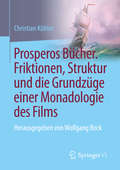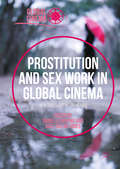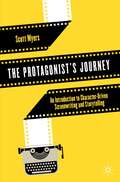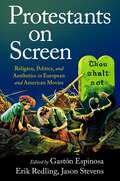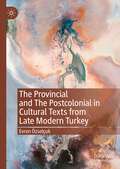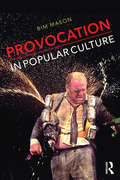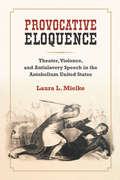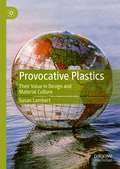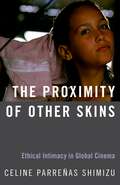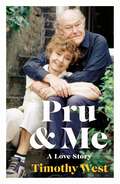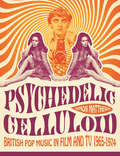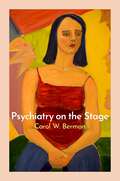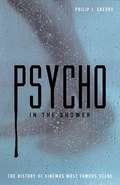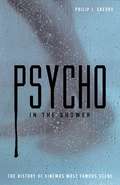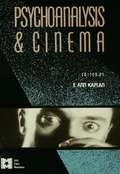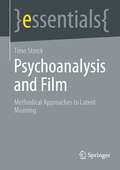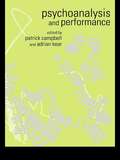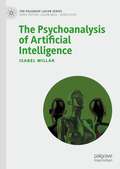- Table View
- List View
Prosperos Bücher. Friktionen, Struktur und die Grundzüge einer Monadologie des Films: Herausgegeben von Wolfgang Bock
by Christian KöhlerChristian Köhlers Buch ist eine komplexe und vielschichtige Arbeit über Peter Greenaways Film Properos Bücher (NL/UK 1991). Der englische Maler und Regisseur experimentierte in seiner Adaption von Shakespeares Theaterstück Der Sturm von 1611 mit einer frühen digitalen Aufnahmetechnik, der „Paintbox“ von Sony. Vor dem Hintergrund der Filmtheorie von Gilles Deleuze analysiert Köhler die Voraussetzungen und Hintergründe dieses Films und interpretiert die Übergänge zwischen empirischem und ästhetischem Leben für die Möglichkeiten des Mediums insgesamt.
Prostitution and Sex Work in Global Cinema: New Takes on Fallen Women
by Danielle Hipkins Kate Taylor-JonesThis volume brings together international scholars to engage in the question of how film has represented a figure that for many is simply labelled ‘prostitute’. The prostitute is one of the most enduring female figures. She has global historical resonance and stories, images and narratives surrounding her, and her experiences, circulate transnationally. As this book will explore, the broad term prostitute can cover a variety of experiences and representations that are both repressive and also have the potential to empower women and disrupt cultural expectations. The contributors aim to consider how frequently 19th-century narratives of female prostitution—hence the label ‘fallen women’—are still recycled in contemporary visual contexts, and to understand how widespread, and in what contexts, the destigmatization of female sex work is underway on screen.
Prostitution and Sex Work in Global Cinema: New Takes on Fallen Women
by Danielle Hipkins Kate Taylor-JonesThis volume brings together international scholars to engage in the question of how film has represented a figure that for many is simply labelled ‘prostitute’. The prostitute is one of the most enduring female figures. She has global historical resonance and stories, images and narratives surrounding her, and her experiences, circulate transnationally. As this book will explore, the broad term prostitute can cover a variety of experiences and representations that are both repressive and also have the potential to empower women and disrupt cultural expectations. The contributors aim to consider how frequently 19th-century narratives of female prostitution—hence the label ‘fallen women’—are still recycled in contemporary visual contexts, and to understand how widespread, and in what contexts, the destigmatization of female sex work is underway on screen.
The Protagonist's Journey: An Introduction to Character-Driven Screenwriting and Storytelling
by Scott MyersCharacter drives plot. Based on this principle, this book walks aspiring writers through the fascinating world of character-driven screenwriting. When a writer engages their characters, they start a process which naturally leads to the story’s structure and everything else that makes for a well-written narrative. Exploring the protagonist’s journey and their “unity arc,” Myers explains how a family of characters surrounds the protagonist and influences their transformation process. This easy-to-follow guide features activities that will help writers of any level develop their stories from concept to scene-by-scene outline. Based upon a popular workshop Myers has led with over a thousand writers at all levels of experience, this book is a must-have for screenwriting students, both undergraduate and graduate, and those looking at advanced story development.
Protestants on Screen: Religion, Politics and Aesthetics in European and American Movies
by Gastón Espinosa, Erik Redling and Jason StevensProtestants on Screen explores the Protestant contributions to American and European film from the silent era to the present day. The authors analyze how Protestant filmmakers, beliefs, theology, symbols, sensibilities, and cultural patterns have shaped the history of film. Challenging the stereotype of Protestants as world-denouncing-and-defying puritans and iconoclasts who stood in the way of film's maturation as an art, the authors contend that Protestants were among the key catalysts in the origins and development of film, bringing an identifiably Protestant aesthetic to the medium. The essays in this volume track key Protestant themes like faith and doubt, sin and depravity, biblical literalism, personal conversion and personal redemption, holiness and sanctification, moralism and pietism, Providence and secularism, apocalypticism, righteousness and justice, religion and race, the priesthood of all believers and its offshoots-democratization and individualism. Protestants, the essays in this volume demonstrate, helped birth and shape the film industry and harness the power of motion pictures for spiritual instruction, edification, and cultural influence.
Protestants on Screen: Religion, Politics and Aesthetics in European and American Movies
Protestants on Screen explores the Protestant contributions to American and European film from the silent era to the present day. The authors analyze how Protestant filmmakers, beliefs, theology, symbols, sensibilities, and cultural patterns have shaped the history of film. Challenging the stereotype of Protestants as world-denouncing-and-defying puritans and iconoclasts who stood in the way of film's maturation as an art, the authors contend that Protestants were among the key catalysts in the origins and development of film, bringing an identifiably Protestant aesthetic to the medium. The essays in this volume track key Protestant themes like faith and doubt, sin and depravity, biblical literalism, personal conversion and personal redemption, holiness and sanctification, moralism and pietism, Providence and secularism, apocalypticism, righteousness and justice, religion and race, the priesthood of all believers and its offshoots-democratization and individualism. Protestants, the essays in this volume demonstrate, helped birth and shape the film industry and harness the power of motion pictures for spiritual instruction, edification, and cultural influence.
The Provincial and The Postcolonial in Cultural Texts from Late Modern Turkey
by Evren ÖzselçukThis book explores Turkey’s complicated relationship to modernity and its status within the new global order by tracing the ambivalent ways in which taşra (the provinces) is constituted in contemporary Turkish cinema and literature. Connoting much more than its immediate spatial meaning as those places outside of the center(s), taşra is a way of naming what modernity decries as spatial peripherality, temporal belatedness, and cultural backwardness. It has functioned historically as a psychosocial repository for what Turkish modernity degrades and disavows, enabling a mapping of the predicaments and contradictions of Turkish modernization and national identity-constitution. Organized around taşra as its central analytic and informed by postcolonial, psychoanalytical, and critical theory, the book examines the extent to which dominant codings of taşra are affirmed and/or complicated in cinematic and literary narratives by award-winning filmmakers Nuri Bilge Ceylan and Fatih Akın and Nobel laureate Orhan Pamuk.
Provocation in Popular Culture
by Bim MasonWhat role can provocation play in the process of renewal, both of individuals and of societies? Provocation in Popular Culture is an investigation into the practice of specific provocateurs and the wider nature of cultural provocation, examining, among others: Banksy Sacha Baron Cohen Leo Bassi Pussy Riot Philippe Petit Archaos. Drawing on Bim Mason’s own twenty-five year career as performer, teacher and creative director, this book explores the power negotiations involved in the relationship between provocateur and provoked, and the implications of maintaining a position on the ‘edge’. Using neuroscience as a bridge, it proposes a similarity between complexity theory and cultural theories of play and risk. Three inter-related analogies for the ‘edge’ on which these performers operate – the fulcrum, the blade and the border – reveal the shifts between structure and fluidity, and the ways in which these can combine in a single moment.
Provocation in Popular Culture
by Bim MasonWhat role can provocation play in the process of renewal, both of individuals and of societies? Provocation in Popular Culture is an investigation into the practice of specific provocateurs and the wider nature of cultural provocation, examining, among others: Banksy Sacha Baron Cohen Leo Bassi Pussy Riot Philippe Petit Archaos. Drawing on Bim Mason’s own twenty-five year career as performer, teacher and creative director, this book explores the power negotiations involved in the relationship between provocateur and provoked, and the implications of maintaining a position on the ‘edge’. Using neuroscience as a bridge, it proposes a similarity between complexity theory and cultural theories of play and risk. Three inter-related analogies for the ‘edge’ on which these performers operate – the fulcrum, the blade and the border – reveal the shifts between structure and fluidity, and the ways in which these can combine in a single moment.
Provocative Eloquence: Theater, Violence, and Antislavery Speech in the Antebellum United States
by Laura L MielkeIn the mid-19th century, rhetoric surrounding slavery was permeated by violence. Slavery’s defenders often used brute force to suppress opponents, and even those abolitionists dedicated to pacifism drew upon visions of widespread destruction. Provocative Eloquence recounts how the theater, long an arena for heightened eloquence and physical contest, proved terribly relevant in the lead up to the Civil War. As antislavery speech and open conflict intertwined, the nation became a stage. The book brings together notions of intertextuality and interperformativity to understand how the confluence of oratorical and theatrical practices in the antebellum period reflected the conflict over slavery and deeply influenced the language that barely contained that conflict. The book draws on a wide range of work in performance studies, theater history, black performance theory, oratorical studies, and literature and law to provide a new narrative of the interaction of oratorical, theatrical, and literary histories of the nineteenth-century U.S.
Provocative Plastics: Their Value in Design and Material Culture
by Susan LambertPlastics have now been our most used materials for over fifty years. This book adopts a new approach, exploring plastics’ contribution from two perspectives: as a medium for making and their value in societal use. The first approach examines the multivalent nature of plastics materiality and their impact on creativity through the work of artists, designers and manufacturers. The second perspective explores attitudes to plastics and the different value systems applied to them through current research undertaken by design, materials and socio-cultural historians. The book addresses the environmental impact of plastics and elucidates the ways in which they can and must be part of the solution. The individual viewpoints are provocative and controversial but together they present a balanced and scholarly un-picking of the debate that surrounds this ubiquitous group of materials. The book is essential reading for a wide academic readership interested in the Arts and Humanities, especially Design and Design History; Anthropology; and Cultural, Material and Social Histories.
The Proximity of Other Skins: Ethical Intimacy in Global Cinema
by Celine Parreñas ShimizuTransnational films that represent intimacy and inequality produce new experiences that result in the displacement of the universal spectator, in a redefinition of the power of cinema for today's global audiences. The Proximity of Other Skins examines transnational films that achieve global prominence in presenting a different cinematic language of love and sex. Author Celine Parreñas Shimizu traverses independent films by Gina Kim and Ramona Diaz to the global cinema of Laurent Cantet, Park Chan-wook and Cannes award-winning director Brilliante Mendoza and their representations of transnational intimacies. In doing so, she addresses unexpected encounters in the global movement of people and goods within their geopolitical, historical, and cultural contexts. In these celebrated films that move across continents, she finds ways to expand our definition of intimacy, including explicit sex and relations that go beyond sex, enabling us the opportunity to theorize how people now live together in many spheres of contemporary life. Readers can then better understand how intimacy can affirm and express love, but also alienate and oppress, revealing the loneliness, pain, and suffering within transnational, national, and personal relations of power and hierarchy. In studying representations of intimacy, the book calls to expand our vocabulary of moving images and its role in redefining care work and affective relations between people across difference and inequality. The book addresses cinematic intimacies between husbands/wives/lovers, understanding between sex workers and clients, close familiarity between rich and poor, and new affinities between citizen and refugee and laborer and capitalist.
PROXIMITY OF OTHER SKINS C: Ethical Intimacy in Global Cinema
by Celine Parreñas ShimizuTransnational films that represent intimacy and inequality produce new experiences that result in the displacement of the universal spectator, in a redefinition of the power of cinema for today's global audiences. The Proximity of Other Skins examines transnational films that achieve global prominence in presenting a different cinematic language of love and sex. Author Celine Parreñas Shimizu traverses independent films by Gina Kim and Ramona Diaz to the global cinema of Laurent Cantet, Park Chan-wook and Cannes award-winning director Brilliante Mendoza and their representations of transnational intimacies. In doing so, she addresses unexpected encounters in the global movement of people and goods within their geopolitical, historical, and cultural contexts. In these celebrated films that move across continents, she finds ways to expand our definition of intimacy, including explicit sex and relations that go beyond sex, enabling us the opportunity to theorize how people now live together in many spheres of contemporary life. Readers can then better understand how intimacy can affirm and express love, but also alienate and oppress, revealing the loneliness, pain, and suffering within transnational, national, and personal relations of power and hierarchy. In studying representations of intimacy, the book calls to expand our vocabulary of moving images and its role in redefining care work and affective relations between people across difference and inequality. The book addresses cinematic intimacies between husbands/wives/lovers, understanding between sex workers and clients, close familiarity between rich and poor, and new affinities between citizen and refugee and laborer and capitalist.
Pru and Me: The Amazing Marriage of Prunella Scales and Timothy West
by Timothy WestAfter first meeting over sixty years ago while filming a costume drama for the BBC, Prunella Scales and Timothy West have enjoyed a partnership like no other; from appearing together in hit sitcoms to bringing up two children, they have chalked up an almost endless list of professional triumphs.In this book, Tim traces their united steps through life professionally and personally, and covers the highs and lows of caring for Pru since her dementia diagnosis, twenty years ago. As with all things in life, she and Tim have tackled it together, often with a glass of wine in hand and almost always with a smile.
Psychedelic Celluloid: British Pop Music in Film & TV 1965 - 1974
by Simon MatthewsPsychedelic Celluloid is the definitive guide to the decade when swinging London was the film capital of the world. Illustrated throughout with colour images of the period and covering over 300 British and European films and TV shows, Psychedelic Celluloid moves from the Beatles via Bond spin offs to crazy personal folies des grandeurs, Blow Up and its imitators, concert movies, documentaries, stylish horror films and many more. Carefully researched and drawing on interviews with some of the survivors of the era, Psychedelic Celluloid provides a witty and detailed account of each major production, listing its stars, directors, producers and music and showing how they were linked to the fashion and trends of the period.'Psychedelic Celluloid covers the swinging sixties in minute detail, noting the influence of pop on hundreds of productions' - The Independent 'While the pop and rock of the 60s has been the subject of innumerable studies, and people have catalogued the films too, often at great length, up until now no one has put the two together' -Little White Lies 'A richly illustrated guide' - The BooksellerONLY SUITABLE FOR VIEWING ON A LAPTOP, COMPUTER or LARGE TABLET
Psychiatry on the Stage: How Plays Can Enhance Our Understanding of Psychiatric Conditions
by Carol W. BermanPsychology and theater have often intersected in the most interesting ways to describe characters, situations, and interactions. Neuroscience is in the process of discovering how the brain longs for patterns that we find in theater and other art forms, and practitioners in psychiatry frequently refer to literature and drama to better understand patients. For instance, the Oedipal complex was first illustrated in Sophocles' Oedipus Rex, and Sigmund Freud largely derived his understanding of psychiatric complexes from his familiarity with Greek mythology. Psychiatry on the Stage presents an overview of basic psychiatric principles applied to plays from the Greeks to modern times. Additional features include illustrative vignettes from the author's practice and several detailed indexes comprised of plays, corresponding playwrights, and various psychiatric and neurological disorders. As a board-certified psychiatrist and playwright, Dr. Berman is uniquely qualified to explore the connections between psychiatry and theater. This book is sure to appeal to both practitioners in the field of psychiatry and theater enthusiasts alike.
Psychiatry on the Stage: How Plays Can Enhance Our Understanding of Psychiatric Conditions
by Carol W. BermanPsychology and theater have often intersected in the most interesting ways to describe characters, situations, and interactions. Neuroscience is in the process of discovering how the brain longs for patterns that we find in theater and other art forms, and practitioners in psychiatry frequently refer to literature and drama to better understand patients. For instance, the Oedipal complex was first illustrated in Sophocles' Oedipus Rex, and Sigmund Freud largely derived his understanding of psychiatric complexes from his familiarity with Greek mythology. Psychiatry on the Stage presents an overview of basic psychiatric principles applied to plays from the Greeks to modern times. Additional features include illustrative vignettes from the author's practice and several detailed indexes comprised of plays, corresponding playwrights, and various psychiatric and neurological disorders. As a board-certified psychiatrist and playwright, Dr. Berman is uniquely qualified to explore the connections between psychiatry and theater. This book is sure to appeal to both practitioners in the field of psychiatry and theater enthusiasts alike.
Psycho in the Shower: The History of Cinema's Most Famous Scene
by Philip J. Skerry"With this book, Philip Skerry makes an ambitious and largely successful effort to restore perspective to the debate that has swirled around Psycho since Hitchcock first ripped back the shower curtain of our expectations in 1960 and plunged his knife into the collective cinematic consciousness." - John Baxter, Film International Psycho in the Shower is a multi-dimensional study of Psycho's astonishing shower scene. Philip J. Skerry shows how it may be the most significant and influential film scene of all and substantiates this claim by providing chapters on the evolution of the scene in Hitchcock's career, with particular focus on his methods for creating suspense and terror in the audience. In tracing the evolution of the shower scene, the author discusses and analyzes many films (both Hitchcockian and otherwise) that lead up to Psycho. The book places the shower scene in the cultural and social contexts of American popular culture of the 1950s and 1960s, arguing that it helped to create a revolution in both sensibility and cinematic style. Several unique dimensions help to set this study apart from other books on Psycho and Hitchcock: extensive and detailed interviews with people who worked on the film, including star Janet Leigh and screenwriter Joseph Stefano (the last significant interviews before their deaths); a close study of Hitchcock's employment of mise en scene and montage in the scenes leading up to the famous shower murder; a shot by shot analysis of the scene itself and a discussion of the numerous controversies surrounding it; and a provocative and insightful account of the writing of the book itself, which provides a unique look at the author's creative process. The book culminates with examples of how the shower scene has become embedded in the matrix of contemporary culture and the remarkable ways in which the scene affected people on first viewing.
Psycho in the Shower: The History of Cinema's Most Famous Scene (Studies In History And Criticism Of Film #Vol. 11)
by Philip J. Skerry"With this book, Philip Skerry makes an ambitious and largely successful effort to restore perspective to the debate that has swirled around Psycho since Hitchcock first ripped back the shower curtain of our expectations in 1960 and plunged his knife into the collective cinematic consciousness." - John Baxter, Film International Psycho in the Shower is a multi-dimensional study of Psycho's astonishing shower scene. Philip J. Skerry shows how it may be the most significant and influential film scene of all and substantiates this claim by providing chapters on the evolution of the scene in Hitchcock's career, with particular focus on his methods for creating suspense and terror in the audience. In tracing the evolution of the shower scene, the author discusses and analyzes many films (both Hitchcockian and otherwise) that lead up to Psycho. The book places the shower scene in the cultural and social contexts of American popular culture of the 1950s and 1960s, arguing that it helped to create a revolution in both sensibility and cinematic style. Several unique dimensions help to set this study apart from other books on Psycho and Hitchcock: extensive and detailed interviews with people who worked on the film, including star Janet Leigh and screenwriter Joseph Stefano (the last significant interviews before their deaths); a close study of Hitchcock's employment of mise en scene and montage in the scenes leading up to the famous shower murder; a shot by shot analysis of the scene itself and a discussion of the numerous controversies surrounding it; and a provocative and insightful account of the writing of the book itself, which provides a unique look at the author's creative process. The book culminates with examples of how the shower scene has become embedded in the matrix of contemporary culture and the remarkable ways in which the scene affected people on first viewing.
Psychoanalysis and Cinema (AFI Film Readers)
by E. Ann KaplanThese fifteen carefully chosen essays by well-known scholars demonstrate the vitality and variety of psychoanalytic film criticism, as well as the crucial role feminist theory has played in its development. Among the films discussed are Duel in the Sun, The Best Years of Our Lives, Three Faces of Eve, Tender is the Night, Pandora's Box, Secrets of the Soul, and the works of Jacques Tourneur (director of The Cat People and other features).
Psychoanalysis and Cinema (AFI Film Readers)
by E. Ann KaplanThese fifteen carefully chosen essays by well-known scholars demonstrate the vitality and variety of psychoanalytic film criticism, as well as the crucial role feminist theory has played in its development. Among the films discussed are Duel in the Sun, The Best Years of Our Lives, Three Faces of Eve, Tender is the Night, Pandora's Box, Secrets of the Soul, and the works of Jacques Tourneur (director of The Cat People and other features).
Psychoanalysis and Film: Methodical Approaches to Latent Meaning (essentials)
by Timo StorckThis essential is dedicated to the connection between psychoanalysis and film. Psychoanalysis is suitable for a methodically guided film viewing. This is not an application of psychoanalytical theory, but rather an application of its method of a reflected relationship to a counterpart. In this way, latent meanings can be taken into consideration and an interpretation can be developed. This essential reconstructs the possibilities of such an approach and presents existing approaches. Finally, a guideline for carrying out a film psychoanalytical interpretation is proposed. Numerous film examples serve to illustrate this.The translation was done with the help of artificial intelligence. A subsequent human revision was done primarily in terms of content.
Psychoanalysis and Performance
by Patrick Campbell Adrian KearThe field of literary studies has long recognised the centrality of psychoanalysis as a method for looking at texts in a new way. But rarely has the relationship between psychoanalysis and performance been mapped out, either in terms of analysing the nature of performance itself, or in terms of making sense of specific performance-related activities. In this volume some of the most distinguished thinkers in the field make this exciting new connection and offer original perspectives on a wide variety of topics, including: · hypnotism and hysteria · ventriloquism and the body · dance and sublimation · the unconscious and the rehearsal process · melancholia and the uncanny · cloning and theatrical mimesis · censorship and activist performance · theatre and social memory. The arguments advanced here are based on the dual principle that psychoanalysis can provide a productive framework for understanding the work of performance, and that performance itself can help to investigate the problematic of identity.
Psychoanalysis and Performance
by Patrick Campbell Adrian KearThe field of literary studies has long recognised the centrality of psychoanalysis as a method for looking at texts in a new way. But rarely has the relationship between psychoanalysis and performance been mapped out, either in terms of analysing the nature of performance itself, or in terms of making sense of specific performance-related activities. In this volume some of the most distinguished thinkers in the field make this exciting new connection and offer original perspectives on a wide variety of topics, including: · hypnotism and hysteria · ventriloquism and the body · dance and sublimation · the unconscious and the rehearsal process · melancholia and the uncanny · cloning and theatrical mimesis · censorship and activist performance · theatre and social memory. The arguments advanced here are based on the dual principle that psychoanalysis can provide a productive framework for understanding the work of performance, and that performance itself can help to investigate the problematic of identity.
The Psychoanalysis of Artificial Intelligence (The Palgrave Lacan Series)
by Isabel MillarThis book examines the crucial role of psychoanalysis in understanding what AI means for us as speaking, sexed subjects. Drawing on Lacanian theory and recent clinical developments it explores what philosophy and critical theory of AI has hitherto neglected: enjoyment. Through the reconceptualization of Intelligence, the Artificial Object and the Sexual Abyss the book outlines the Sexbot as a figure who exists on the boundary of psychoanalysis and AI. Through this figure and the medium of film, the author subverts Kant’s three Enlightenment questions and guides readers to transition from asking 'Does it think?' to 'Can it enjoy?' The book will appeal in particular to students and scholars of psychoanalysis, philosophy, film and media studies, critical theory, feminist theory and AI research.
